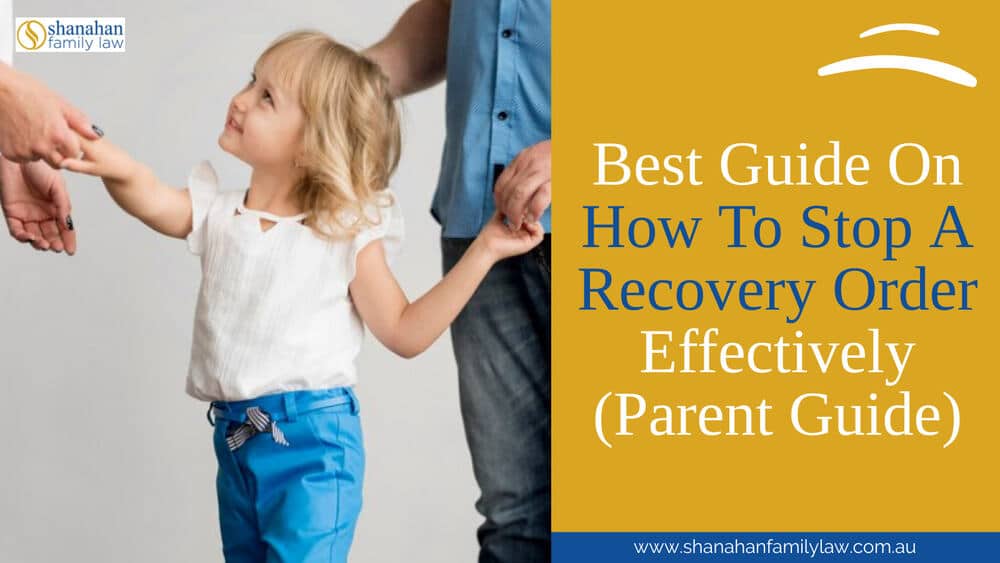
Having your child removed from your care by some other party is a scary and confusing situation to have to handle.
However, the Court can use appropriate legal mechanisms to help you track down a missing child and have it returned to your care through a child recovery order. As with other family law matters, child recovery orders can be complex.
This article explores recovery orders, outlines the process of applying for one, and provides guidance on how to stop a recovery order if you find one has been served against you.
Understanding these steps is crucial for effectively managing such a challenging and emotional legal issue.
What is a recovery order?
As per section 67Q of the Family Law Act 1975, a recovery order is a family court order that compels the return of a child to:
- One of the child’s parents;
- A person concerned with parental responsibilities for the child;
- A person named in a parenting order has the right to communicate, live, or spend time with the child.
Who can apply for a recovery order?
A person permitted by a parenting order to have parental responsibility for, or maintain a connection with, the child in question may apply for a recovery order. Grandparents and anyone concerned about the child’s welfare may also make an application.
Applying for child recovery orders
You cannot apply for a child recovery order without an existing parenting order. When you have a parenting order before the court, a recover order care proceedings may be attached by submitting an ‘application in a proceeding’ form.
The application should have an affidavit attached to it detailing the facts in support of a child recovery order.
Without a parenting or child custody order in place, you must begin with an initiating application for parenting orders and include a recovery order as part of your submission.
After the court receives the application, a court date will be set within 14 days after the filing, if practicable. The implementation may take several weeks if the order is not considered urgent.

Supporting documentation
Affidavit
The affidavit submitted with the application includes the relevant facts behind the recovery order. Information contained in the affidavit may consist of the following:
- Relationship history. A history of your relationship, including who the parties are, when it started, the marriage date and the separation date;
- Information about the children. List your children’s names and dates of birth. If an Apprehended Violence Order (AVO) is in place, attach a copy to the affidavit. Attach a copy of any current parenting plans or orders.
- Caring roles before and after separation. Detail the parenting arrangements regarding accommodation, education, healthcare, etc. Provide information about who the primary carer was during the relationship and after the separation. Include details about what the primary caring role entailed.
- Current parenting arrangements. Explain the current arrangements for your children’s welfare, including their accommodation, education and healthcare.
Notice of Child Abuse, Family Violence or Risk
An applicant must file a Notice of Child Abuse, Family Violence or Risk form with their recovery order application. This notice poses specific questions regarding risks to you or your children, including instances of child abuse or family violence.
This form ensures that children at risk of abuse receive the necessary targeted early intervention. Child abuse allegations recorded on the form will be reported to child welfare authorities.
Cover letter
Including a cover letter with your application can help to communicate urgency to the Court. A cover letter explains why the Court should hear your application right away.

Implementing a recovery order
Once the court grants a recovery order, it takes immediate effect. Generally, it lasts for 12 months unless otherwise specified in the order. The matter passes to the relevant authority, usually the Australian Federal Police (AFP), for execution.
The AFP needs information about the background of the situation before acting on a recovery order. You must provide as much information on anyone involved as possible through a ‘recovery order information sheet’.
International Child Abduction
When you believe the other parent has taken your child overseas or may be about to, there are different steps to consider.
Contact the AFP for assistance placing your child’s name on the family law watchlist. The AFP uses this watchlist to track the movements of children who are the subject of a parenting order or other court order and identify if they are leaving the country.
We recommend that you seek legal advice. A court order is required to place your child’s name on the family law watchlist.
Hague Convention
When your child is in a country that’s part of the Hague Convention on the Civil Aspects of International Child Abduction, the Australian Central Authority (ACA) may assist you. Resources are available on the Commonwealth Attorney General’s Department website.
The Hague Convention is a multilateral treaty that applies to 96 countries. It protects children from abduction and retention across international borders. Australia became a signatory to the convention in 1987. The convention seeks to return children to their home country and secure a parent’s access to their children. Your child must be held in a country that is a signatory of the treaty to use this legal avenue.
Separate agreements exist for children held in Egypt or Lebanon. The Attorney General’s website also has specific application forms for these agreements.
Some children are abducted to countries that aren’t part of the Hague Convention treaty. You can get help from the Consular Branch of the Department of Foreign Affairs and Trade (DFAT). If you don’t know where your child was taken, it’s still worth making an application to the ACA.

Applying for a recovery order under the Hague Convention
The first step is to seek legal advice from a family lawyer. Legal action involving recovery orders can be complex. Issues involving international relations are even more challenging.
The application process is as follows:
- Form 1. You begin by filing a Form 1, which can be found on the Attorney General department’s website. The application asks for information about the child, yourself, the person you believe abducted them and other relevant information. The form authorises the ACA to take all reasonable action on your behalf.
- Supporting affidavit of fact. This affidavit tells your side of the case regarding your child’s abduction. It should be as detailed as possible, including specific details rather than broad statements. The affidavit must include whether there are existing Australian court orders that don’t remove your parental responsibility for the child. A Justice of the Peace should witness the affidavit.
- Birth certificate. Attach a certified copy of the child’s birth certificate. This helps demonstrate that you have ‘rights of custody’ of the child.
- Other documentation. Other documents may be required as part of the application, including:
- Marriage/ divorce certificate
- Copy of parenting plan.
- Correspondence between yourself and the abducting person.
- Rental agreements.
- Travel documents.
- Bank statements.
- Employment records.
5. After the application. If the application is granted, the ACA will transfer it to the relevant child abduction authority in the other country. The overseas authority may set up mediation, organise for a voluntary return or file in court. If court action is taken, there may be several hearings. The applicant and respondent will both have a chance to provide evidence supporting their case.
Other relevant orders
Location order
The court may grant a location order to compel someone with information on the child’s location to divulge it. Location orders are relevant if the child is still within Australia. The order usually lasts 12 months or longer if the Court determines it’s appropriate. Any information about the child’s location will only be provided to the Court.
Anyone eligible for a recovery order can also apply for a location order.
Commonwealth information order
A Commonwealth information order can require that an Australian government department such as Centrelink provide any information it acquires regarding the location of a child subject to a recovery order.
Publication order
Any information associated with a recovery order is extremely sensitive and should not be shared. Breaching these rules can attract a penalty of up to one year of imprisonment.
However, there may be times when it’s appropriate to allow the media to publish details of a limited extent, along with photographs of the child and anyone who may be with them.
A publication order details what information is acceptable and what specific wording publications should include. Publication orders are generally only made as a last resort. Other mechanisms, such as location orders, will be pursued first.
Read this blog to know more about location order.
How to stop a recovery order? Can I fight it?
When you find that you are the recipient of a child recovery order, there are avenues you can pursue to fight against it.
The first option is to take a non-legal path. Connect with the other party and negotiate a way to settle the matter. If you cannot contact them, ask a friend, family member, or a family lawyer to do so on your behalf if possible.
Federal Circuit Court and Family Court of Australia
If you choose the legal route, you can submit a response to the court with an affidavit explaining your position and the facts relevant to your side of the story. If the issue is urgent, the matter may be heard in court, perhaps even without your reply.
The Federal circuit courts treat each family law case as a unique matter. To understand how it approaches them, consider decisions from previous court hearings.
There are 3 essential points you will need to show to stop a recovery order:
- There was an urgent need for you to relocate;
- You had agreed with the other parent that you would move to a new location;
- There is a natural and present threat of physical or psychological harm to you or your child’s life.
What if the Australian Federal Police are involved?
When the AFP has the order referred to them, you mustn’t do anything to hinder their investigation, as this is illegal under the Family Law Act.
Please seek legal advice as soon as possible since this issue is time-sensitive.
The Australian Federal Police have a family law kit. This is a general guide on police and family law.

Seek legal advice
When you want to apply for an emergency recovery order or fight one granted against you, seek legal assistance to understand your rights and responsibilities.
The application process for family court orders can be complex and requires the correct information for success.
An experienced family lawyer can ensure that if an application form or written statement is being submitted to a family court judge, it satisfies the court’s requirements.
Conclusion
Like other family law orders, recovery orders should be handled carefully to protect your child’s best interests. It’s best to resolve the issue amicably with your former partner if possible.
Likewise, if you are fighting against a recovery order, negotiating outside of court is the best solution for all involved. In any case, if court orders are necessary, always obtain appropriate legal aid before proceeding.
If you have further questions on how to stop a recovery order, book a free discovery call today.
If you need help with family law matters, contact us for a free discovery call.
The above information is intended to be general advice only and is not a substitute for personalised advice. Because it does not consider your individual circumstances, it is not intended to be relied upon, and any loss or damage arising from any such reliance is disclaimed. Any financial or legal decisions should only occur after you have received tailored advice from a legal or financial professional.
Related Articles
- What Is a Location Order and Recovery Order in Australia? (Updated)
- How to Protect Your Child’s Best Interests in Child Custody in Australia
- Parental Plan: Make A Perfect Plan For Your Children’s Care
- Discover The Deep Impact Of Parental Separation On Children’s Growth
- Explore the 4 Practical Tips for Healthy Parenting After the Separation

